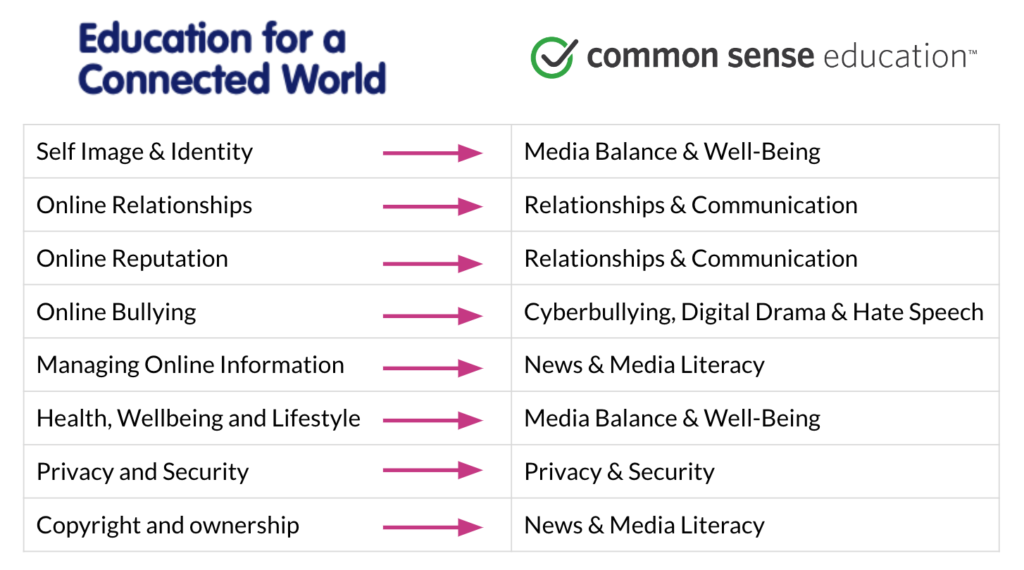Keep safe and create
National Curriculum Links - Computing KS1
The content of this plan cover the following National Curriculum strands:
- recognise common uses of information technology beyond school
- use technology safely and respectfully, keeping personal information private; identify where to go for help and support when they have concerns about content or contact on the internet or other online technologies.
- use technology purposefully to create, organise, store, manipulate and retrieve digital content
Why this? What does it build on?
This unit gives important early lessons on keeping safe online. We hope this builds on work from Early Years, where they are likely to have early conversations and stories about being safe when using electronic devices and going online and how to ask for help when they have problems. This unit also builds on the Year 1 unit Keeping safe and exploring technology and further develops creative skills for dealing with text and images learned in our Year 1 unit Making multimedia stories and An introduction to digital art.
What comes next?
The digital literacy content in this unit will be built upon in much greater depth with our Digital Literacy and online safety units for Year 3, Year 4, Year 5, and Year 6. These units come from Common Sense Education's excellent Digital Citizenship curriculum and cover a wide range of themes that deliver a comprehensive online safety and digital literacy curriculum.
View our full curriculum map
Take a look at our full curriculum map to see how units across all year groups, from Year 1 to Year 6 link.
A note about this unit
![]()
Three lessons in this unit or work are taken from Common Sense Education’s excellent Digital Citizenship curriculum. Their resources are shared for free under A Creative Commons Attribution- NonCommercial- NoDerivatives 4.0 International License. As a result, this plan can be accessed without logging into our site and is FREE FOR ALL TO USE. It can be shared and used by anyone under the terms of that license. The original materials can be found at: https://www.commonsense.org/education/uk/digital-citizenship
Education for a Connected World
The Education for a Connected World framework describes the Digital knowledge and skills that children and young people should have the opportunity to develop at different ages and stages of their lives. It highlights what a child should know in terms of current online technology, its influence on behaviour and development, and what skills they need to be able to navigate it. Common Sense resources are recommended in the Education for a Connected World framework as essential skills for today's learners. Both resources together, along with Project Evolve, provide you with an excellent set of tools to deliver a comprehensive online safety and digital literacy curriculum.
Education for a Connected World's strands align with Common Sense Education's Digital Citizenship strands in the following way:

Look out for more detail in each of the lessons in this unit, about the strands and statements from Education for a Connected World that link to each lesson.
Unit Resources
Key vocabulary for this unit
Control – using computers to move or otherwise change ‘physical’ systems. The computer can be hidden inside the system or connected to it.
Digital citizen - someone who uses technology responsibly to learn, create, and participate.
Digital media - information that comes to us through the internet, often through a tablet, smartphone, or laptop.
Internet – the global collection of computer networks and their connections, all using shared protocols (TCP/IP) to communicate.
Media - all of the ways that large groups of people get and share information (TV, books, internet, newspapers, phones, etc).
Media balance - using media in a way that feels healthy and in balance with other life activities (family, friends, school, hobbies, etc).
Media choices - time spent watching, listening to, reading, or creating media.
Network - A network consists of multiple devices that communicate with one another. It can be as small as two computers or as large as billions of devices. While a traditional network is comprised of desktop computers, modern networks may include laptops, tablets, smartphones, televisions, gaming consoles, smart appliances, and other electronics.
Online - using a digital device to visit a website or app that makes use of the internet.
Private information - information about you that can be used to identify you because it is unique to you (e.g. your full name or your address)
Server - A server is a computer that serves up information to other computers on a network. Schools and many businesses will have a file server that pupils and employees can use to store and share files. A server can look like a regular desktop computer, or it can be much larger.
World Wide Web – a service provided by computers connected to the internet (web servers), in which pages of hypertext (web pages) are transmitted to users; the pages typically include links to other web pages and may be generated by programs automatically.
Related units
Programming Direction
You need to be logged in to view this content. Please Log In. Not a Member? Join Us
An Introduction to Digital Art
You need to be logged in to view this content. Please Log In. Not a Member? Join Us
Action Algorithms
You need to be logged in to view this content. Please Log In. Not a Member? Join Us
Making Multimedia Stories
You need to be logged in to view this content. Please Log In. Not a Member? Join Us
Exploring Digital Sound
You need to be logged in to view this content. Please Log In. Not a Member? Join Us
Exploring Machines We Control
You need to be logged in to view this content. Please Log In. Not a Member? Join Us

